 |
New York
Architecture Images-Soho St. Patrick’s Old Cathedral (RC) Landmark |
|
architect |
Joseph-Francois Mangin |
|
location |
260-264 Mulberry St. |
|
date |
1809-15 |
|
style |
Gothic Revival |
|
construction |
|
|
type |
Church |
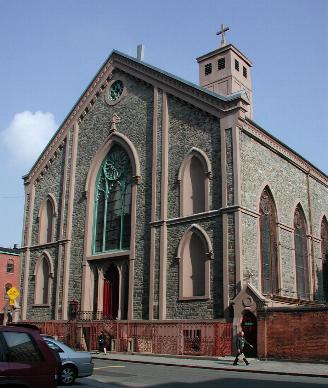 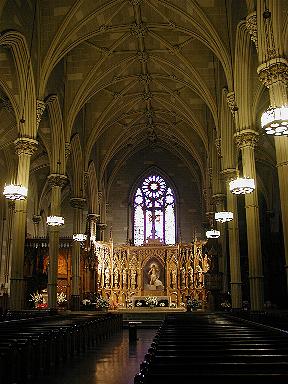 |
|
Special thanks to
www.churchcrawler.co.uk
(British and international church architecture site) for generous
permission to use above images. |
|
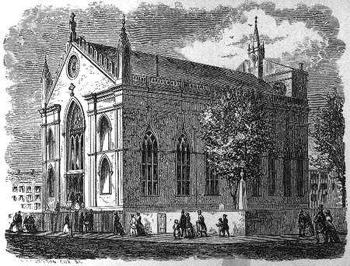 |
|
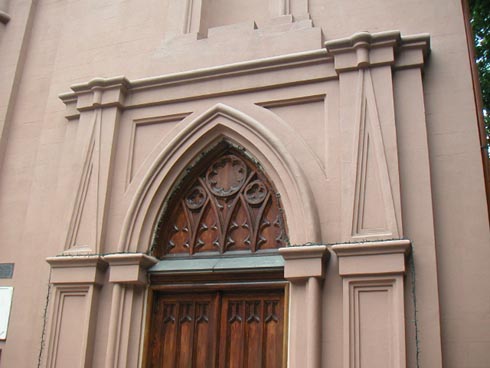 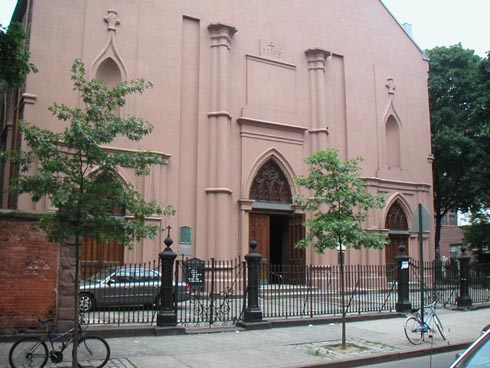 |
|
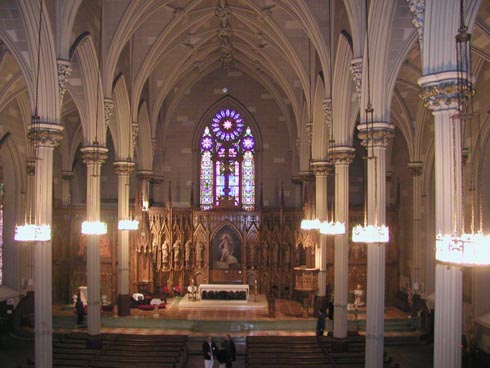 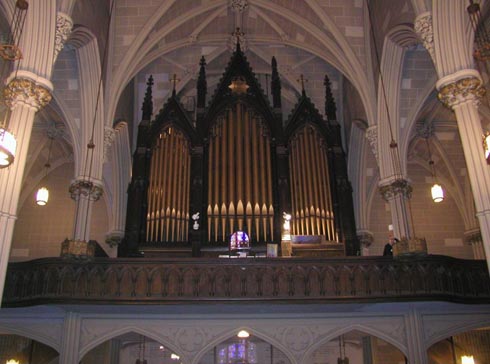 |
|
|
notes |
The original St Patrick's Cathedral in New York City was then, as the new one now, the center of religious life for members of the Archdiocese of New York and the seat of the Archbishop. The oldest Roman Catholic church building in New York City, it played vital social and political roles in the lives of young immigrants, helping them adapt to their new home Now known as Old St Patrick's, the cathedral on Prince and Mott streets had served the Irish immigrant population since 1809. Land for a new cathedral was purchased in 1852 and construction started in 1859. Before the new cathedral could be completed, St Patrick's was ravaged by fire in 1866. The cathedral was restored and rededicated by John Cardinal McClosky in 1868 Mangin was designing the cathedral while his most prominent work, New York City Hall was being constructed. Though more Gothically ecclesiastical, one can see echoes of Mangin's City Hall design in the cathedral. On June 8, 1809 the cornerstone of the original St. Patrick's "Old" Cathedral‚ was laid . On May 14, 1815, it was dedicated and the New York Gazette described it as "a grand and beautiful church, which may justly be considered one of the greatest ornaments of our city...." St. Patrick's Old Cathedral was New York's first Cathedral, at the start of this Country, the first Roman Catholic Cathedral in America named for the Patron Saint of Ireland. St. Patrick's has dignity and character in its stark simplicity. The side walls are 75 feet high, the inner vault is 85 feet high. The church measures over 120 feet long and 80 feet in width. the huge marble altar near the western wall, surrounded by ornately hand-carved, gold leaf reredos, containing some of the finest religious statuary in the United States. On the very same grounds you will find New York City's only Russian Catholic Church - St. Michael's - still celebrating its ancient liturgies every week. The complex includes six buildings, all listed on the National Register of Historic Places - including St. Patrick's school, which served as a Revolutionary War hospital and was called "Dead House" Later it was transformed into an orphanage where America's first Saint, Mother Elizabeth Seton, established her order- the Sisters of Charity. The building was gifted to the church by Cornelius Heeney, an early 19th century philanthropist who loved children. An 18th century graveyard surrounds St. Patrick's. The Rectory is located in the Bishop's former residence at 263 Mulberry Street, not far from the church. At the other end of St. Pat's is the choir loft and the historic 1868 Henry Erben pipe organ. Henry Erben was the most well known organ builder not in New York City and America, in general. Underneath the church there is a labyrinth of mortuary vaults and the cemetery outside contains old graves and tombstones. Buried here is the Venerable Pierre Toussaint, a Black New Yorker, born a slave in Haiti, whose elevation to sainthood is now under study in Rome. St. Patrick's is also the original burial site of Bishop Hughes - "Dagger John" and New York's first Bishops. Founders of the Emigrant Savings Bank have family plots in the crypt; Andrew Carrigan, Peter Hargous and others. Also interred here are Dominic Lynch, first President of the Friendly Sons of St. Patrick and a ratifier of the Constitution. Countess Annie Leary, the first woman in America to be made a Papal Countess, also rests below the cathedral. St. Patrick's Old Cathedral has been the site of many important events in American history. In1835, Bishop John Hughes was forced to assemble the parishioners to defend the Cathedral against anti-Catholic and anti-immigrant mob violence that threatened the Cathedral. Chanting epitaphs such as "Paddies of the Pope..." these vigilantes were determined to "burn her to the ground." The need to defend the Cathedral against mob-violence wasn't uncommon. The "Know Nothing Party" organized Protestants to march on St. Patrick's. Hughes wrote to New York Mayor James Harper saying "Should one Catholic come to harm, or should one Catholic business be molested, we shall turn this city into a second Moscow." Archbishop Hughes' decision to arm the Ancient Order of Hibernians and position them on the walls surrounding the Cathedral, prevented these attempts, but the anti-papist mob did stone the beautiful stained glass windows of both the church and the Bishop's residence. Hibernian Hall was located across the street from St. Patrick's in the 1800s continued to defend the church and its priests during times of both turbulence and peace. Not all of the Cathedral's history was troubled. St. John Neuman was ordained to the priesthood at St. Patrick's. Archbishop Hughes was the first priest elevated to the Episcopate in St. Patrick's and on Tuesday, April 27th, 1875, Archbishop John McCloskey received the zucchetto rosso, the red-skull cap, in St. Patrick's, Pope Pius IX having made him the very first American Cardinal. Attending the auspicious occasion were future U.S. President Chester Arthur, Mayor William H. Wickham, and other leaders of the day. With the outbreak of the Civil War, President Lincoln invited Archbishop Hughes to represent America as his envoy to France, Spain and England, hoping to dissuade them from aiding and abetting the Southern Confederacy. Shortly after President Lincoln called for troops, the "Fighting 69th" Regiment, lead by Colonel Michael Corcoran, Thomas Francis Meagher and former Congressman, U.S. Attorney and Abolitionist - Captain John McKeon, headed off to what would be the Battle of Bull Run - and they were the only Union regiment that did not flee. The New York Irish Brigade, mainly men of the parish, fought heroically for the Union and the abolition slavery. Many of those soldiers lie in the cemeteries surrounding St. Patrick's. Seventy-five-percent of the Irish Brigade died in battle. War's end left with many widows and orphans. A few years later, with the emigration of the Italians to America the neighborhood changed from Irish to Italian , giving the neighborhood its new name - Little Italy. The Italian community soon made St. Patrick's theirs and have contributed some of the finest stained-glass work in North America to the church, as well as many vocations.
St. Patrick’s Old Cathedral is a church of the people, generations after generations, built modern day America. This church nurtured the Irish, Germans, French, and Italian communities as they arrived in this new world. Italian-Americans and Dominicans comprise today’s parish . The Chinese community is served at the church on Broome Street - Most Holy Crucifix, established in 1925. St. Patrick’s Old Cathedral is in “The Heart of Old New York”, Little Italy - on the edge of the Bowery and SoHo, just north of Chinatown. St. Pat's parish is robust, regularly celebrating liturgies in English, Spanish and Chinese. Serving this community for almost 200 years, St. Patrick’s Old Cathedral looks forward to serving for many years to come. |
|
links |
http://www.oldsaintpatricks.com/ |